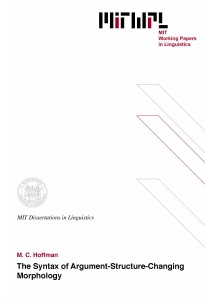The Syntax of Argument-Structure-Changing Morphology
M. C. Hoffman, 1991
The study of the causative and applicative constructions in Bantu languages gives us an insight into some complex applications of theories of argument structure and Case theory. This thesis develops a theory of lexical complementation which gives a unified account of causative and applicative constructions and double object constructions of all types: all these multiple object constructions are examples of predicate-predicate complementation. Causatives are examples of VP-VP complementation, while applicatives, locative alternation verbs, and dative double object verbs are examples of VP-PP complementation. Complementation involving PP is examined in some detail, as a theory of Preposition Inversion is developed and shown to be responsible for applicative asymmetries. In addition, a theory of licensing involving movement to functional heads accounts for a number of object properties in Bantu.
Chapter 1 gives the theoretical background for the thesis, which includes a syntactic theory of argument structure in which the argument structure of a predicate takes the form of syntactic trees, and head-to-head movement may take place at a level of representation known as lexical syntax.
Chapter 2 develops an account of licensing (Case-marking) in which NPs may be licensed in one of three ways: through Spec-Head agreement with a functional projection LP (Licensing Phrase), to which NP moves at LF; through sisterhood with a predicate head; and through Spec-Head agreement with a specially licensing lexical predicate. This chapter also shows how this analysis explains the symmetrical object/asymmetrical object division among Bantu languages.
Chapter 3 focuses on applicative constructions in Chichewa, Kinyarwanda, and Sesotho, and dative, benefactive, and locative alternation verbs in English. It develops the basic notion that prepositions express relations between two grammatical items into a theory of Preposition Inversion, whereby a preposition can express the relation it denotes in either of two directions. If a P combines with an NPI into a P’ and is predicated of an NP2, the relation between NP2 and NP1 via P’ may also be expressed by NP2 combining with P and being predicated of NP1. In addition, prepositions may relate either two entities (NPs) or an entity and an event (an NP and a VP); entity-entity prepositions are responsible for lexical variations such as locative and dative alternations, while entity-event prepositions are used in productive applicative constructions. Word order and object property differences among different types of applicatives in Bantu languages are accounted for using P Inversion to construct different hierarchical relations within a single type of structure involving a VP and a PP.
Chapter 4 examines causative constructions in a variety of languages (Turkish, Japanese, Chi-Mwi:ni, Chichewa, Kinyarwanda, Sesotho, Chamorro, and Quechua) and uses the theory of licensing developed in Chapter 2 to characterize the differences among them. Chapter 5 examines some residual issues, such as the co-occurrence of causative and applicative morphemes and WH-movement and NP-movement asymmetries in multiple object constructions.
Thesis Supervisor: Kenneth Hale
Title: Ferrari P. Ward Professor of Modern Languages and Linguistics
<br/>
Table of Contents
Chapter 1 Introduction 9
1.1 Overview of the thesis 9
1.2 Argument structure 11
1.2.1 Representation, categories, and movement operations 15
1.2.2 Thematic relations, projection, and the UTAH 15
1.2.2.1 L-syntactic structure as thematic relations 22
1.2.2.2 Projection to s-syntax and the UTAH 26
1.2.2.3 External arguments 28
1.2.3 Lexical complementation in the syntax 30
1.3 Licensing (Case Theory) 31
1.4 Object properties and object symmetry 38
1.4.1 Passive 40
1.4.2 Object marking 42
1.4.3 Other object properties 44
1.5 Summary of Chapter 1 45
Chapter 2 Licensing 46
2.1 Previous accounts of and uses for Structural Case 46
2.1.1 Larson (1988a) 49
2.1.2 Aoun and Li (1989) 56
2.1.3 Chomsky (class notes, 1990) 59
2.2 A proposal for a system of licensing 63
2.3 L-licensing and object symmetry 69
2.3.1 Asymmetrical object constructions with upper object
L-licensing 69
2.3.1.1 Licensing structure 69
2.3.1.2 Passive 72
2.3.1.3 Object marking 73
2.3.2 Asymmetrical object constructions with lower object
L-licensing 75
2.3.2.1 Licensing structure 75
2.3.2.2 Passive 78
2.3.2.3 Object marking 79
2.3.3 Symmetrical object constructions 80
2.3.3.1 Licensing structure 80
2.3.3.2 Passive 83
2.3.3.3 Object marking 84
2.3.4 Summary of licensing variations 85
2.4 Summary of the theory of licensing 86
Chapter 3 Applicatives 88
3.1 Preposition inversion 89
3.1.1 Double object constructions 90
3.1.1.1 Prepositional dative à double object 90
3.1.1.2 Double object à prepositional dative 93
3.1.1.3 Separate structures 94
3.1.2 Locative alternation verbs and inversion 95
3.1.3 The lexical benefactive alternation 106
3.1.3.1 English benefactives 106
3.1.3.2 Event-entity Ps 108
3.2 Characteristics of applicative constructions 116
3.2.1 Benefactive applicatives 117
3.2.2 Other types of applicatives 121
3.3 Applicative alternations as P inversion 126
3.4 Previous analyses 135
3.4.1 Marantz (1984, 1990) 135
3.4.2 Baker (1988a,b) 138
3.4.3 Intransitive verbs and applicatives 140
3.4.3.1 Chichewa optional object verbs 140
3.4.3.2 A solution 145
3.5 Summary and conclusions 148
Chapter 4 Causatives 150
4.1 Types of causative constructions 151
4.2 The structure of the synthetic causative 154
4.3 The position of the causee 157
4.4 The licensing of the causee 158
4.4.1 Type 1 causatives (causee is L-licensed) 160
4.4.1.1 Kinyarwanda 160
4.4.1.2 Chi-Mwi:ni 162
4.4.1.3 Sesotho 163
4.4.1.4 Imbabura Quechua and Chamorro 166
4.4.1.5 Japanese 168
4.4.1.6 Sumary of Section 4.4.1 175
4.4.2 Type 2 causatives (only lower object is L-licensed) 176
4.4.2.1 Turkish 177
4.4.2.2 Chichewa 179
4.4.2.3 Summary of Section 4.4.2 182
4.4.3 Summary of the types of causatives 183
4.5 Conclusion 184
Chapter 5 Residual Issues 185
5.1 Causatives and applicatives together 185
5.1.1 Affix ordering 186
5.1.2 Triple object structures 189
5.2 Double object verbs in oddity in Kinyarwanda 194
5.2.1 Locative applicatives 194
5.2.2 Locatives with double object verbs 197
5.2.3 Benefactives and locatives 203
5.3 Sesotho intransitive verbs 204
5.4 Object marking asymmetries in symmetrical object languages 208
5.5 Object properties and WH-movement 216
5.6 Conclusion 228
Chapter 6 Conclusion 229

